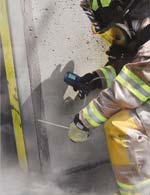
AIHA White Paper Outlines Respiratory Research Needs
Are user seal checks necessary to ensure protection? And, if so, when should they be performed? A white paper prepared by the American Industrial Hygiene Association's Respiratory Protection Committee asks these and several other questions to resolve important issues.
- By Jerry Laws
- Jan 01, 2010
The American Industrial Hygiene Association’s Respiratory Protection Committee has issued a new white paper explaining where its members believe research is needed to increase the safe and effective use of respiratory protection. Divided into seven proposals, the white paper starts by recommending a comprehensive literature search to summarize what is known about respirators’ performance and says no clear consensus exists today about the “correct” way to measure performance or to interpret results from various techniques being used.
“In recent years, the field of respiratory protection has experienced unprecedented, substantial opportunities and challenges,” AIHA said in its announcement of the paper’s release. “The establishment of the National Institute for Occupational Safety and Health (NIOSH) National Personal Protective Technology Laboratory (NPPTL) provides a focal point for research and standard setting for new classes of respiratory protective devices. The increased demand for protection from chemical, biological, radiological, and nuclear (CBRN) hazards; outbreaks of life threatening viruses; and new technologies for more precise characterization of aerosol particle sizes, respiratory hazards, and respirator performance are generating increased interest in this subject area. The AIHA Respiratory Protection Committee determined this is an opportune time to consider respiratory protection research topics and priorities.”
The seven proposals are described in the announcement as “high-priority research topics”:
1) Measurement of respirator performance
2) Qualitative fit testing for full-facepiece respirators
3) Appropriateness of fit factor safety margin criterion
4) Investigation of in-facepiece contaminant measurement technology and methodology
5) Determining the necessity and value of each respiratory protection program requirement
6) Effectiveness of user seal checks
7) Determine whether organic vapors desorb from PAPR cartridges during periods of non-exposure
Proposal 2, Qualitative fit testing (QLFT) for full-facepiece respirators, recommends developing a QLFT capable of screening for a minimum fit factor of 500. This would allow facepieces to be qualitatively fit tested for use in atmospheres where exposures are as high as 50 times the occupational exposure limit. QLFT appeals to smaller employers with limited resources, so this new test would increase small employers’ compliance with fit testing requirements, the committee predicts.
Proposal 5 could have the greatest impact among the seven proposals. If such a study is undertaken, it would prove whether streamlined programs could be as effective at protecting workers as traditional programs. The importance of the traditional program elements, as required by OSHA, “has never been systematically studied,” the committee writes, and while it is possible all of the elements are needed, it is also possible one or more may not be.
Proposal 6 concerns ascertaining whether user seal checks are effective and, if so, when they should be performed. The checks are required by regulations and emphasized in users’ training, but “it is likely that few workers do them at every donning in the workplace,” the document states. If they don’t improve protection, the fact many workers don’t do them is not a major concern. But if they do improve protection, this recommendation should increase the likelihood they will be performed, the committee finds.
The committee intended the recommendations to influence NIOSH, which certifies respirators, and also universities and independent researchers as they investigate and improve respiratory protection. For more information, contact Respiratory Protection Committee Chair Jay A. Parker, CIH, at 412-386-5227 or [email protected] or Aaron Trippler, AIHA’s director of Government Affairs, at 703-846-0730 or [email protected].
About the Author
Jerry Laws is Editor of Occupational Health & Safety magazine, which is owned by 1105 Media Inc.